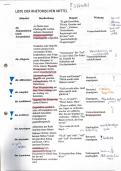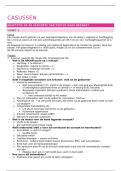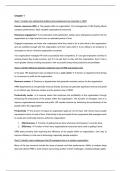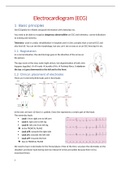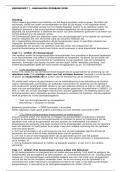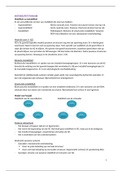Week 1: Identifying key sources of evidence through the use of
appropriate search strategies
Learning Objectives
Defining evidence in public health: origin and major sources of contemporary public health
evidence and their qualitative and quantitative features
Formulation of a research question and search strategy
Contents
Common Data Types in Public Health Research ............................................................................ 1
Qualitative Data .......................................................................................................................... 1
Quantitative Data ........................................................................................................................ 3
Data Sources ................................................................................................................................... 4
Primary Data Sources ................................................................................................................. 4
Secondary Data Sources ............................................................................................................. 5
Defining Evidence in public health................................................................................................. 9
Searching for research evidence in public health ......................................................................... 10
Developing a research question ................................................................................................ 10
PICOT format ........................................................................................................................... 11
FINER criteria ........................................................................................................................... 12
, Data sources .............................................................................................................................. 14
Search strategy .......................................................................................................................... 16
Citation searching ..................................................................................................................... 19
Supplementary search techniques ............................................................................................. 20
Grey literature ........................................................................................................................... 20
Evaluating Sources.................................................................................................................... 21
References: .................................................................................................................................... 24
,Common Data Types in Public Health Research
The implementation and evaluation of public health interventions and policy relies on the access
of data from many different sources. There are two types of data in public health research:
qualitative and quantitative data.
Qualitative Data
Qualitative research provides data about meaning and context regarding the people and
environments of study. Broadly speaking, qualitative research tends to answer the “why?” and
“how?” questions surrounding public health topics.
Qualitative methods are often employed when generating hypotheses which may be later
developed into interventions and tested in randomised controlled trials. Moreover, qualitative
research can provide additional understanding about a research topic that may be inaccessible
using quantitative methods: for example, understanding why patients fail to adhere to prescribed
treatments; why people undertake certain healthy (and unhealthy) behaviours; what concerns
people have about their health and ill health; and how people conceptualise their illnesses.
Qualitative research methods can provide insight into the perceptions, values, opinions, and
provide understandings which specialists and researchers may not have considered beforehand. It
can evaluate economic, political, social and cultural contextual factors that influence health
(Public Health Action Support Team (PHAST), 2020a) (Wolf et al., 2018). Qualitative data is a
broad category of data that can include almost any non-numerical data which can be observed,
but not measured (Common Data Types in Public Health Research, 2018).
1
, Collection and nature of qualitative data
Data collected in qualitative studies typically are in the form of text or visual images, which
provide rich sources of insight but also tend to be bulky and time-consuming to code and
analyze. Examples of qualitative data include: male/female, smoker/non-smoker, or
questionnaire response (agree, disagree, neutral). Practically speaking, qualitative study designs
tend to favor small, purposively selected samples. The combination of purposive sampling and
open-ended question formats deprive qualitative study designs of the power to quantify and
generalize conclusions, one of the key limitations of this approach. Open-ended techniques are
particularly useful for understanding subjective meanings and motivations underlying behavior.
They enable investigators to be equally skilled at exploring factors observed and unobserved,
intentions as well as actions, internal meanings as well as external consequences, options
considered but not taken, and unmeasurable as well as measurable outcomes. These methods are
important when the source of or solution to a public health problem is rooted in local perceptions
rather than objectively measurable characteristics selected by outside observers.
Ultimately, the decision whether to include qualitative research in a particular field investigation
depends mainly on the nature of the research question itself. Certain types of research topics lend
themselves more naturally to qualitative rather than other approaches. These include exploratory
investigations when not enough is known about a problem to formulate a hypothesis or develop a
fixed set of questions and answer codes. They include research questions where intentions matter
as much as actions and “why?” or “why not?” questions matter as much as precise estimation of
measured outcomes. Qualitative approaches also work well when contextual influences,
2
appropriate search strategies
Learning Objectives
Defining evidence in public health: origin and major sources of contemporary public health
evidence and their qualitative and quantitative features
Formulation of a research question and search strategy
Contents
Common Data Types in Public Health Research ............................................................................ 1
Qualitative Data .......................................................................................................................... 1
Quantitative Data ........................................................................................................................ 3
Data Sources ................................................................................................................................... 4
Primary Data Sources ................................................................................................................. 4
Secondary Data Sources ............................................................................................................. 5
Defining Evidence in public health................................................................................................. 9
Searching for research evidence in public health ......................................................................... 10
Developing a research question ................................................................................................ 10
PICOT format ........................................................................................................................... 11
FINER criteria ........................................................................................................................... 12
, Data sources .............................................................................................................................. 14
Search strategy .......................................................................................................................... 16
Citation searching ..................................................................................................................... 19
Supplementary search techniques ............................................................................................. 20
Grey literature ........................................................................................................................... 20
Evaluating Sources.................................................................................................................... 21
References: .................................................................................................................................... 24
,Common Data Types in Public Health Research
The implementation and evaluation of public health interventions and policy relies on the access
of data from many different sources. There are two types of data in public health research:
qualitative and quantitative data.
Qualitative Data
Qualitative research provides data about meaning and context regarding the people and
environments of study. Broadly speaking, qualitative research tends to answer the “why?” and
“how?” questions surrounding public health topics.
Qualitative methods are often employed when generating hypotheses which may be later
developed into interventions and tested in randomised controlled trials. Moreover, qualitative
research can provide additional understanding about a research topic that may be inaccessible
using quantitative methods: for example, understanding why patients fail to adhere to prescribed
treatments; why people undertake certain healthy (and unhealthy) behaviours; what concerns
people have about their health and ill health; and how people conceptualise their illnesses.
Qualitative research methods can provide insight into the perceptions, values, opinions, and
provide understandings which specialists and researchers may not have considered beforehand. It
can evaluate economic, political, social and cultural contextual factors that influence health
(Public Health Action Support Team (PHAST), 2020a) (Wolf et al., 2018). Qualitative data is a
broad category of data that can include almost any non-numerical data which can be observed,
but not measured (Common Data Types in Public Health Research, 2018).
1
, Collection and nature of qualitative data
Data collected in qualitative studies typically are in the form of text or visual images, which
provide rich sources of insight but also tend to be bulky and time-consuming to code and
analyze. Examples of qualitative data include: male/female, smoker/non-smoker, or
questionnaire response (agree, disagree, neutral). Practically speaking, qualitative study designs
tend to favor small, purposively selected samples. The combination of purposive sampling and
open-ended question formats deprive qualitative study designs of the power to quantify and
generalize conclusions, one of the key limitations of this approach. Open-ended techniques are
particularly useful for understanding subjective meanings and motivations underlying behavior.
They enable investigators to be equally skilled at exploring factors observed and unobserved,
intentions as well as actions, internal meanings as well as external consequences, options
considered but not taken, and unmeasurable as well as measurable outcomes. These methods are
important when the source of or solution to a public health problem is rooted in local perceptions
rather than objectively measurable characteristics selected by outside observers.
Ultimately, the decision whether to include qualitative research in a particular field investigation
depends mainly on the nature of the research question itself. Certain types of research topics lend
themselves more naturally to qualitative rather than other approaches. These include exploratory
investigations when not enough is known about a problem to formulate a hypothesis or develop a
fixed set of questions and answer codes. They include research questions where intentions matter
as much as actions and “why?” or “why not?” questions matter as much as precise estimation of
measured outcomes. Qualitative approaches also work well when contextual influences,
2





